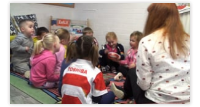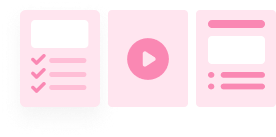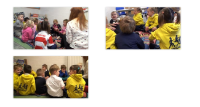Families Level: Early Grades - Skills & games
Music Lesson Description
The Music Dog Goes Round and Round (pulse)
Our pets are part of the family too! Here's a passing game and song about Maestro the Music Dog. I start off here with tapping the pulse on knees and many children eventually learn to pass the music dog in time with the pulse of the music.
Instrument Twins (timbre)
You need a set of identically paired instruments that make a different sound (timbre) eg two drums, two wood blocks, two scrapers, two maracas. Supposing you have six pairs of instruments, give one of each pair to a child, invite them to explore the sound the instruments make and help the children to name them all.
Put the other set of identical instruments behind a screen, keeping the others in the circle. One child hides behind a screen and plays an instrument from the identical set.
Ask the children 'Which instrument was that?' (invite hands up). Ask both children holding the identical instruments to make a sound on them again. Then a different child hides behind the screen and the game begins again.
Organisational hint - ask the children who have already played to put the instrument behind their back so they are not tempted to continue playing it once you have moved the game on to the next pair.

Copy Cats
Copy Cat Mirrors (structure)
This is a game to be played standing up, facing the children. The aim is for the children to copy you, as if in a mirror, as you do a sequence of movements. First you do one action and the children copy it after you, then you do a different action for them to copy. Next you do both actions over and over again without stopping as the children copy you at the same time, as if in a mirror. Build up to four movements, then do them again without stopping.
Copy Cat Sounds (dynamics, pitch, duration)
Next, you might do some movements with sounds, such as clapping and stamping, as well as some without sounds, such as touching your shoulders. You could vary loud and quiet dynamics, high-pitched and low-pitched vocal sounds and long-duration and short-duration sounds.






